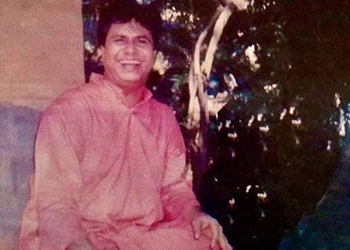The birthday celebration of Guru Maharaj for the last 9/10 years was held in Ajimgunj. How was the birthday celebrated – I will talk about that context later. At first, I will say about the contribution of those devotees who were involved with this ashram. Bijoy Daa(Bijoy Pal) Bobin Daa(Swami Akhilananda), Bishnu Daa(Bishnu Dubey- all these devotees were the citizens of Ajimgunj city. Ajimgunj junction is a thinly populated place. There are only rail quarters in this junction and the village Diar-Mahinagar is situated in the east of this junction. Ajimgunj city is one or 1.5 kilometres away in the north-west from this place. Noticing the name , it is clear that the main Ajimgunj city is situated here. However, Bijoy Daa was an educated man (B.A at that time) and he was well aware of accounts. As a result, from the beginning of the establishment of Ajimgunj Paramananda Mission, he kept the accounts of income and expenditure of the ashram . Firstly, as local people and secondly, his fame as a tutor – managing all these, he as well as the other two collected a large sum of money for the ashram. But in case of a large help for the ashram, Sengupta Babu (the father of Brahmachari Subrata of Banagram Paramananda Mission), Doctor Bidhan, Manik Brahma, Khokan Daa ( brother- in-law of Debasish) and later the devotees of Berhampur ( especially Salil Babu – he was the professor of English of K.N College) helped the ashram very much. But Manik Brahma was at the top in the beginning. When Bijoy Daa and Bishnu Daa went to him for financial help, he never upset them – he donated lavishly. Debashish was deeply involved with the ashram from the time of building construction of the ashram or just few days later after the commencement of the building construction of the ashram – I heard all these from him.
Then there was a group of devotees including Sengupta Babu, Bidhan Doctor etc. When they went to Banagram, they went in groups. There is a wide variety of mangoes in the district Murshidabad - nowhere is produced so many species of mangoes. The names of these mangoes are very beautiful - Golapkhas, Ranipasand, Begambahar and so many but Kohitur is the best. The cultivation of this 'Kohitur' mango is very rare. Though some is cultivated, the citizens of this country do not get the opportunity to taste this mango. These mangoes are exported abroad by plane. When should these mangoes be plucked, how should the mangoes be kept in a cotton wool and when should it be eaten - only the gardener knows all these details. So after plucking the Kohitur mangoes and after keeping these mangoes in a cotton wool, the gardener writes date and time on it, so that after eating the mango in right time the buyer can enjoy its right taste. If anyone eats the mango before or after that fixed time, he or she will taste bad.
After hearing those words from them, one day Guru Maharaj told in a sitting, "Look, Sengupta Babu ( Sengupta Babu was present in the sitting that day) - you, the inhabitants of the district Murshidabad come to the ashram. You tell about the greatness of various mangoes of that place. You also say about various tastes of those mangoes but you never made us the participants of taste of that mango. Will you speak the words of greatness of mangoes only in mouth?" Then Sengupta Babu said to Him, "But Gurudeb (guru), during the mango season ( mid-May to mid-June), when I have come to you I have surely brought species of mangoes of very good quality for you." Then Guru Maharaj said to him with a sweet smile on His face, "Sengupta Babu, you bring a kg or 2 kgs of mangoes in a paper bag. But how do I eat those mangoes? Here, this Paramananda Mission is a large family. So many boys and girls - without feeding all of them, how do I eat those mangoes? You reply it. So, I send those mangoes to the orphan boys which you bring for me. They use those mangoes as 'prasad' of evening prayer. Now, in this situation (1992/93), if you bring at least a quintal of mangoes, then perhaps I can get a mango."
After hearing those words that day - the devotees, present in the sitting, were able to realise the true reality. Many of us brought food items in a paper bag for Guru Maharaj and thought that Guru Maharaj would be very pleased after eating those food items. But alas, our thoughts were wrong on a large scale. As a mother who holds a womb is not able to eat good food not feeding her children - how can Mother Paramananda eat good food not feeding His children? After that sitting of Guru Maharaj, if the devotees of Ajimgunj sent mangoes to the ashram, they sent a quintal of mangoes to the ashram. Not only the devotees of Ajimgunj, the devotees of other places also sent mangoes as more as possible instead of a paper bag of mangoes to the ashram. For the purpose of this work, they themselves donated a large sum of money. This tradition is going still now. The devotees of Nabadwip (Gour, Shibu and others), the devotees of Chuchura and the devotees of other places also bring mangoes loading a matador (one kind of vehicle) entirety in Banagram Ashram, so that not only the orphan boys but also all the inhabitants of the ashram can enjoy to taste one or two mangoes. After this incident, there started a custom to feed the boys of the ashram fish or meat. A group of devotees sent a quintal of fish or meat to the ashram. Perhaps, they send those food items still now.[Translated by Ramprasad, a former student of Banagram Ashram.]

